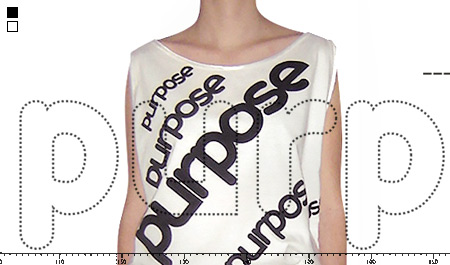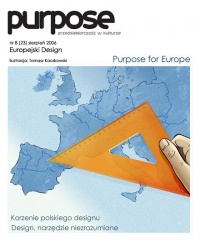
Feature
"To be designed"
Of course, modern art of design is not architecture only. Art of design is everything: advertisements, magazines, clothes, television, Internet…We live in a world of the circulation of meanings, symbols and that’s why the art of design, as a branch that refers to issues of visual communication, is so triumphant. If art has lost its way in the mercantile space of modern cities, design just the opposite – lives with it and owing to it. If the inflation of the ideologies of the 20th century deprived artists of the theoretical base for their activities and made them unable to justify their actions, the art of design, resistant to such doubts, draws the conviction about its freedom from the lack of clear ideological guidelines. Design is free because it doesn’t need to justify its status by referring to high-flow slogans. Design is free because, apart from the issues of the so-called “physiology of vision”, perception, principles of compositions or psychology (mainly in its social variety), it can ignore everything. It is not about discovering any “metaphysical” truths, but about the exchange of stimuli, nearly subliminal communication, about the effect of infatuation with, seduction by a sign. We have to do here with something extremely intelligent and ingenious. Post-modern world, anchored in ideological vacuum, constitutes itself through the universe of twinkling symbols whose only activity should consist in mutual referring, circulation, wild acceleration. Why am I writing about “vacuum”? Let’s look at urban graffiti – those signs, extremely suggestive and artistically refined, actually say nothing. They mean themselves. They mean that they mean. This is a little like an iridescent spot of oil spilled over the surface of a dead lake on whose bottom nothing exists (maybe there is even no bottom?!).
Nothing will avoid ”being designed” – even music, this reportedly freest and liveliest of arts gave way to the temptation of style. There are no sounds, no melody, no rhythms, there are styles - more and more clarified, specified by the whole range of subtle “stylistic” distinctions. Styles split and specify themselves. All of us – whether we want it or not – are designed because we think in such categories, the categories of style. More and more artists are aware of that entanglement, and that’s why musicians are trying to play with styles, putting too much emphasis on their being designed.

illustration: Tomasz Kaczkowski
The universe of signs, existing outside structuralism, expands infinitively. Another thing - the whole designing activity is closely linked to marketing. One cannot ignore this issue because it expresses highly significant power relations.
Even if design is free and unhindered in its quest, it serves certain goals. It not always is pure information that enables our orientation in the world (both the real one and the one in the hyper-real space of the modern media) - design is usually at the service of advertising. Here “the issue of style” most frequently means an asset of thoughts and behaviours imposed on the public to make them addicted to the product advertised. Recently, I have seen a photograph by Matt Siber – his project (called “An Untitled Project”) consisted in taking pictures of streets, shop windows, and then wiping out all advertising slogans, brands, logotypes (they were transferred to a blank sheet of paper attached to each photograph). The impression is rather gloomy. The streets photographed are quiet, but extremely “empty”. On the other hand, advertising slogans and signs often offend with their absurdity. So would our perception be so strongly channelled to the reception of marketing lodestars that we cannot do without them? Does the post-modern man feel “at home” only in places where he can find some familiar advertisements, signs of McDonald’s, H&M’s, Zara’s? Are we able to build up our identity, both individual and collective, through those signs only? If that is true, specialists in marketing and designers at their service will still be swamped with work.
While evaluating the phenomenon of the art of design it is impossible to avoid ambivalence. On the one hand, the confidence in the future and in the real development of fields related to design is fascinating (perhaps the development of new technologies will result in changes in the structure of human perception), on the other hand however, one has to think about some sort of accompanying lack of reflection. It is not about thoughtlessness of designers’ doings – just the opposite, their activities are extremely strict by referring to a number of specific branches of science. What I mean here is a different kind of reflection – closer to what Matt Siber tried to suggest in his project. I mean questions about a goal, about incapacitation, about the identity of the audience. And whether this designed world is the only possible one. It certainly is a world in which we feel safer (basically, it’s because of the fact that we find the same advertising signs in every place on the earth that we can feel relatively safe and at ease everywhere). However, I don’t trust any techniques that aim at making me adapted to the world. I prefer to feel unsafe because only such state can make me ask real questions, endeavour new quests, wander about, fail and get fascinated.
Check the archive

nr 23 August 2006
theme of the issue:
EUROPEAN DESIGN
< spis treści
Article
Purpose for Europe
Presentation
European design
Analysis
Polish design roots - Artur Zaguła
Career in Culture
Brand "kikina" - interview with Elena Kikina
Culture Industries
Image design - Maciej Mazerant
Young Culture
I want to awaken the consciousness of the recipient - conversation with Lotte van Laatum
Feature
"To be designed" - Kuba Wandachowicz
On the Margin
Design, misunderstood tool - Jose Luis Casamayor





